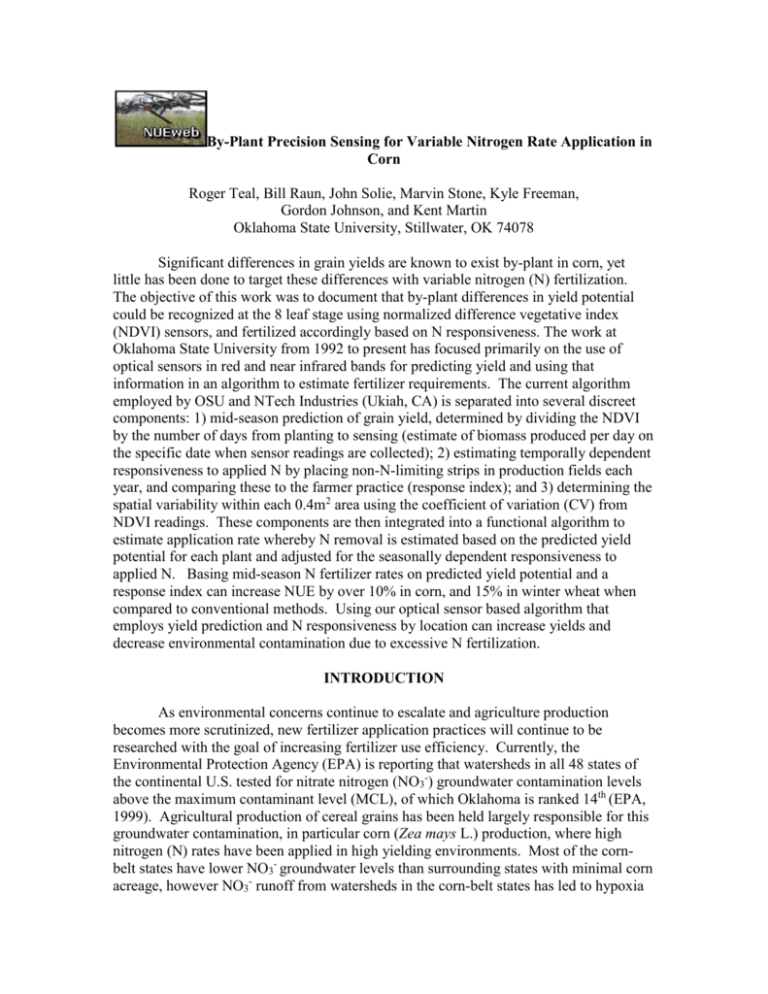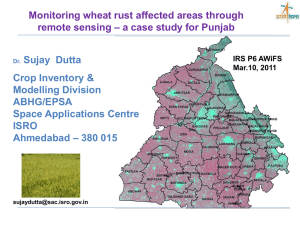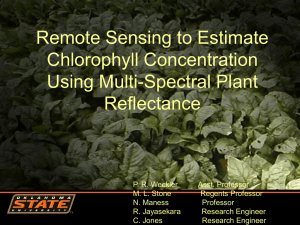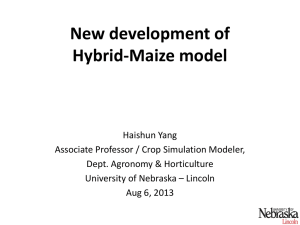By-Plant Precision Sensing for Variable Nitrogen Rate Application in
advertisement

By-Plant Precision Sensing for Variable Nitrogen Rate Application in
Corn
Roger Teal, Bill Raun, John Solie, Marvin Stone, Kyle Freeman,
Gordon Johnson, and Kent Martin
Oklahoma State University, Stillwater, OK 74078
Significant differences in grain yields are known to exist by-plant in corn, yet
little has been done to target these differences with variable nitrogen (N) fertilization.
The objective of this work was to document that by-plant differences in yield potential
could be recognized at the 8 leaf stage using normalized difference vegetative index
(NDVI) sensors, and fertilized accordingly based on N responsiveness. The work at
Oklahoma State University from 1992 to present has focused primarily on the use of
optical sensors in red and near infrared bands for predicting yield and using that
information in an algorithm to estimate fertilizer requirements. The current algorithm
employed by OSU and NTech Industries (Ukiah, CA) is separated into several discreet
components: 1) mid-season prediction of grain yield, determined by dividing the NDVI
by the number of days from planting to sensing (estimate of biomass produced per day on
the specific date when sensor readings are collected); 2) estimating temporally dependent
responsiveness to applied N by placing non-N-limiting strips in production fields each
year, and comparing these to the farmer practice (response index); and 3) determining the
spatial variability within each 0.4m2 area using the coefficient of variation (CV) from
NDVI readings. These components are then integrated into a functional algorithm to
estimate application rate whereby N removal is estimated based on the predicted yield
potential for each plant and adjusted for the seasonally dependent responsiveness to
applied N. Basing mid-season N fertilizer rates on predicted yield potential and a
response index can increase NUE by over 10% in corn, and 15% in winter wheat when
compared to conventional methods. Using our optical sensor based algorithm that
employs yield prediction and N responsiveness by location can increase yields and
decrease environmental contamination due to excessive N fertilization.
INTRODUCTION
As environmental concerns continue to escalate and agriculture production
becomes more scrutinized, new fertilizer application practices will continue to be
researched with the goal of increasing fertilizer use efficiency. Currently, the
Environmental Protection Agency (EPA) is reporting that watersheds in all 48 states of
the continental U.S. tested for nitrate nitrogen (NO3-) groundwater contamination levels
above the maximum contaminant level (MCL), of which Oklahoma is ranked 14th (EPA,
1999). Agricultural production of cereal grains has been held largely responsible for this
groundwater contamination, in particular corn (Zea mays L.) production, where high
nitrogen (N) rates have been applied in high yielding environments. Most of the cornbelt states have lower NO3- groundwater levels than surrounding states with minimal corn
acreage, however NO3- runoff from watersheds in the corn-belt states has led to hypoxia
and anoxia in the Gulf of Mexico. Goolsby et al. (2001) reported that the annual total N
flux to the Gulf of Mexico for 1980-1996 was 1,568,000 t yr-1, and that tripled in the last
30 years, particularly increasing between 1970 and 1983. Hypoxia and anoxia has
severely stressed every major estuary and coastal marine ecosystem around the world to
the point of threshold of change or collapse resulting in loss of fisheries, loss of
biodiversity, and alteration of food webs (Diaz, 2001). Raun and Johnson (1999)
reported worldwide NUE estimates to be approximately 33%, with developing countries
at 29% and developed countries approachingt 42% NUE. As a result, N fertilizer losses
were valued at about $15.9 billion dollars annually, which as of August of 2001 has
increased to $20 billion dollars annually with the price of N fertilizer nearly doubling due
to the shortages of natural gas (Raun et al., 2002). Excessive N applications to cereal
grain crops continue to pollute the environment, increasing human health risk and costing
farmers needless additional expenses along with negative publicity. This exemplifies the
need for continued research to improve fertilizer use efficiency.
Current strategies for winter wheat in Oklahoma recommend that farmers apply
33 kg N ha-1 for every 1 Mg of anticipated wheat yield (2 lb N ac-1 for every bushel of
expected wheat grain yield) they hope to produce, subtracting the amount of NO3-N in
the surface (0-15 cm) soil profile (Johnson et al., 2000). When grain yield goals are
applied using this strategy, the risk of predicting the environment (good or bad year) is
placed on the producer, especially when farmers take the risk of applying all N preplant.
Schmitt et al. (1998) reported similar recommendations of 20 kg N ha-1 for every 1 Mg of
corn (1.2 lb N ac-1 for every bushel of corn) minus soil test NO3-N and/or any credits
from previous leguminous crops in the rotation. To some extent, university extension
(e.g., soil testing), fertilizer dealers, and private consulting organizations have historically
used grain yield goals, due to the lack of a better alternative, and because producers have
been able to relate to an input/output strategy for computing N requirements.
Chlorophyll meters (SPAD meters) have been successfully used to determine inseason N status, since chlorophyll content has been highly correlated with leaf N
concentration (Wolfe et al., 1988; Schepers et al., 1992). With the chlorophyll meters,
researchers developed an N Sufficiency index [(as-needed treatment/ well-fertilized
treatment) * 100] from which recommendations were made for in-season N fertilizer
applications when the index values fell below 95% (Blackmer and Schepers, 1995;
Varvel et al., 1997). Varvel et al. (1997) reported that maximum grain yields in corn
were attained when early season sufficiency indexes ranged between 90 and 100% up to
the V8 growth stage, but if the sufficiency index fell below 90% at V8, maximum yields
were not realized due to early season N deficiency resulting in lost yield potential.
Peterson et al. (1993) indicated that variation in chlorophyll meter measurements can
fluctuate up to 15% from plant to plant, requiring considerable measurements in order to
maintain a representative average for the field at each sampling date. Another drawback
of the chlorophyll meter is that by reading one leaf at a time, plant biomass cannot be
determined as with the remote sensor.
Johnson et al. (2000) developed an N response index (RIHarvest) that calculated the
actual crop response to applied N by dividing the highest mean yield from an N fertilized
treatment by the mean yield in the check treatment receiving no fertilizer N. This work
defining RIHarvest only explains the final yield response to fertilizer N, thus, an in-season
RI estimate must be made in order for in-season N adjustment. Recent work has shown
that in-season normalized difference vegetation index sensor readings{NDVI =
[(NIRref/NIRinc) – (Redref/Redinc)]/[(NIRref/NIRinc) + (Redref/Redinc)]} were highly
correlated with final grain N uptake (Lukina et al., 2001; Raun et al., 2002). Therefore,
an in-season RI from NDVI, referred to as RINDVI (Highest mean NDVI N treatment/
Mean NDVI check treatment), was evaluated and determined to be a viable method for
measuring the potential response to additional N (Mullen et al., 2003).
Raun et al. (2001) showed that yield potential could be estimated from midseason sensor reflectance measurements (Feekes 4 to 6) in winter wheat. Their work
employed the NDVI computed from red and near infrared reflectance values [NDVI =
(NIR-Red)/(NIR+Red)]. NIR and Red are the reflectance measurements in the near
infrared and red bands, respectively. This work predicted yield using the sum of two post
dormancy sensor readings (NDVI) divided by the cumulative growing degree-days or
GDD ((Tmin + Tmax)/2-4.4°C) from the first to the second readings. Tmin and Tmax
are the minimum and maximum temperatures in a 24 hour period. Their index, in-season
estimated yield, or INSEY was later modified whereby a single NDVI measurement was
divided by the number of days from planting to sensing, counting only those days where
GDD > 0 (Raun et al., 2002). This method eliminated those days where growth was not
possible as a function of temperature, regardless of the soil moisture conditions. Raun et
al. (2002) showed that N fertilization based on mid-season estimates of yield potential
increased NUE by more than 15% when compared to traditional practices which applied
N at uniform rates. A significant key to the success of this work was collecting sensor
readings from each 1m2 area and fertilizing each 1m2, recognizing that the differences in
yield potential and subsequent fertilizer need exists at this spatial scale. This spatial scale
was determined in earlier work, where extensive soil sampling, optical sensor
measurements of plants, and geostatistical analyses, showed that significant differences in
N availability existed at a 1m2 spatial resolution and that each square meter needed to be
treated independently to maximize benefits (Raun et al., 1998 ; Solie et al., 1999). Earlier
work by Solie et al. (1996) noted that the fundamental field element for sensing and
treating fertility differences is that area which provides the most precise measure of the
available nutrient where the level of that nutrient changes with distance.
Coefficients of variation were first employed as a relative measure of variation.
The CV is defined as the standard deviation expressed as a percentage of the mean
(Tippett, 1952; Senders, 1958). Mills (1924) indicated that the CV is affected by the
value of the mean, as well as by the size of the standard deviation. Coefficients of
variation have been used to evaluate results from different experiments involving the
same units of measure, possibly conducted by different persons (Steel et al., 1997). Little
and Hills (1978) indicated that the variability among experimental units within
experiments which have different units of measurements and/or plot sizes can be
compared by CVs. Steel et al. (1997) stated that the CV is a relative measure of
variation, in contrast to the standard deviation, which is in the same units as the
observation. Taylor et al. (1999) evaluated the relationship between the CV from grain
yields and plot size. This work showed that CV’s decreased with corresponding
decreases in plot sizes. This research suggested that the small plot sizes were consistent
with the resolution where detectable differences in soil test parameters existed and should
be treated independently. Research conducted at the International Maize and Wheat
Improvement Center (CIMMYT) suggested that the use of within row CV’s in corn could
be used to detect the physiological growth stage when expressed spatial variability was
the greatest from readings collected on a daily basis throughout the growth cycle (Raun et
al., 2004).
The time of sensing is critical to determine potential yield of the crop. Raun et al.
(1986) showed that corn seedlings that emerge late essentially become weeds competing
for moisture and nutrients, with almost no chance of reproductive development. Late
germination can result in competitor plants that reduce yield. Sensing late germination,
the products of which are expressed in a smaller plant, could be very important with midseason N management. Late emergence within a competitive stand will almost assuredly
lead to decreased yield potential, and as a result, mid-season N fertilization should be
compensated accordingly. Swanson and Wilhelm (1996) reported that maximum yields
were achieved by planting corn around May 10 (near Lincoln, NE) and that yields
declined when planting was delayed beyond this time. The same trend for late corn
planting dates to result in decreased grain yields was shown by Dungan (1944), Ahmadi
et al. (1993), and Mascagni and Boquet (1996).
Extensively distributed information on how corn plants develop has been
available from Iowa State University (1993). The following discussion comes from their
site as it relates to early-season detection of yield potential. At the 6-leaf vegetative stage
(V6) the growing point and tassel are above the soil surface and the stalk is beginning a
period of increased elongation. By the 9-leaf stage (V9) an ear shoot (potential ear) will
develop from every above-ground node, except the last six to eight nodes below the
tassel. Initially, each ear shoot develops faster than the ear shoots originating above it on
the stalk. However, growth of most lower stalk ear shoots eventually slows, and only the
upper one or two ear shoots ever develop into a harvestable ear. The tassel begins to
develop rapidly now and the stalk is continuing rapid elongation. Although the ear
shoots (potential ears) were formed just before tassel formation (V5), the number of
ovules (potential kernels) on each ear and the size of the ear are determined by the 12 leaf
stage (V12). In this discussion, it is clear that even though much can be discerned
concerning yield potential at V6, waiting until V12 would provide a much clearer picture
of potential grain yield. While mid-season growth and development is important,
planting date has always held critical yield defining information for corn.
DISCUSSION
Knowing the exact stage of growth where expressed plant variability is at a
maximum might lead to the identification of times when in-season fertilization could
have the greatest impact. One field experiment conducted by Raun et al. (2004) at the
International Maize and Wheat Improvement Center (CIMMYT) measured daily plant
growth and spatial variability in corn (Zea mays L.) over the entire growth cycle using
optical sensor readings (NDVI) collected every 0.05 m in length, 0.6 m wide from 4 corn
rows, 27 m in length. The average plant spacing over all four rows was 21±7 cm. The
mean, standard deviation and CV were calculated from NDVI measurements for each
row and sensing date. NDVI measurements ranged from 0.20 (slightly above average
bare soil) 18 days after planting to near 0.81 at 10 leaf growth stage (V10) 54 days after
planting (Figure 1). However, coefficients of variation peaked at V6, 33 to 35 days after
planting (Figure 2). Expressed spatial variability decreased from >30% at V6 to just
under 10% at V11, but a sharp increase immediately followed with the initiation of
tasseling, lastly just briefly (2 days) until tasseling was completed.
As canopy closure began to develop at V6, larger plants started to cover smaller
plants within the linear row, resulting in the masking of smaller plants and inflating
NDVI values for the smaller plants. The ability to detect by-plant differences decreased
along with soil coverage as the amount of visible green vegetation increased and the
sensing of bare soil associated with uneven plant stands and missing plants declined,
reducing CV (Figure 2). Figure 3 outlines this occurrence as periodically low in-row
NDVI measurements before canopy closure at V8, increased dramatically after canopy
closure. With the greatest spatial variability of NDVI values occurring at V6, this may be
the most opportune time to apply in-season foliar N fertilizer assuming that the spatial
variability encountered at this stage would correlate with final yield potential and that a
response to applied N could be achieved. A second CV peak occurred between VT and
R1 (2 to 3 days), along with a decline in NDVI measurements due to the variation in the
development of the tassels. The light yellow-green pigment in tassels results in reduced
reflectance and lower NDVI measurements for the more mature plants, while the plants
with immature tassels had higher NDVI measurements since their tassels were darker
green. However, once all tassels matured, the CV’s dropped again due to the color
uniformity.
Trials at two locations were established in 2002 with three hybrids, two plant
populations, and three different N rates. Starting in 2003 multiple NDVI measurements
were taken throughout the growing season at both locations (Figures 4 & 5). At the
Haskell location NDVI peaked at V9 and was maintained at V16. During that time
period, the NDVI measurements between different treatments were not distinguishable.
This could be attributed to the possibility of complete canopy closure, resulting in no soil
background reflectance with NDVI. However, NDVI values decreased considerably at
the next measurement at R1 as a result of tassel development. As indicated earlier, the
yellow pigment of the tassel decreases reflectance, resulting in lower NDVI. This is
further signified by the inverse between N sufficient and N deficient treatments. The N
sufficient treatments had greater tassel development over time, but lower NDVI
measurements when compared to N deficient treatments. At the Lake Carl Blackwell
site, plant population affected the NDVI peak, with the higher plant population (51,870
seeds ha-1) peaking between V9 and R1 and the lower population (35,568 seeds ha-1)
peaking at R1. This is a clear indication that in the lower plant population the soil
background reflectance was maintained throughout the growing season and that the
NDVI measurements increased proportionally with plant biomass beyond the influence of
tassel development. Also the higher plant population canopy closure was limited as well
since NDVI did not lower sufficiently at R1 and R2 (Figure 4).
At the Haskell site CV’s collectively were high at the V6 and V8 vegetative
stages and dropped to very low levels at V10 and V16, but increased to levels similar to
early vegetative stages at R1 (Figure 6). However, the greatest variation in treatments
occurred at V8, where the N sufficient treatments reduced CV when compared to N
deficient treatments at the same population. Also it is apparent that as observed by the
NDVI measurements, the lower plant population (49,400 seeds ha-1) was still high
enough to reduce variation, particularly when complete canopy closure was achieved at
V10. At the Lake Carl Blackwell site, plant population sufficiently effected CV, with the
lower population having higher variation. Collectivity, high CV’s were observed for V6
through V8, but the highest variation between N treatments was seen at V7 (Figure 7). In
the higher population, variation between the N treatments declined over time with the
lowest CV’s at V15. Holding consistent with the Haskell site, CV’s increased from V15
to the R1 stage with tassel development. The lower population showed similar results to
the by-plant data from 2002 in Mexico, finding a steady decline with increased plant
biomass, once the N response occurred. This supports the NDVI data, suggesting that the
lower plant population left enough distance between plants to maintain soil background
reflectance until reproductive stages.
By-plant prediction of corn grain yield is based on determining plant biomass in
mid-season via a NDVI measurement. Current work has shown that NDVI alone might
not be able to predict corn plant biomass accurately (Figure 8), but when combined with
plant height, plant biomass can be measured with great accuracy (Figure 9)(Kyle
Freeman, personal communication, June 2004). For this work, 3 rows of 50 corn plants
at two different locations were sensed by-plant with a modified GreenSeekerTM Hand
Held Optical Sensor Unit (Ntech Industries, Inc.) mounted on a bicycle with a shaft
encoder to log distance (1 reading per cm of linear distance traveled) with each NDVI
measurement. Following NDVI measurements, plant height was determined for each
plant by extending the last collared leaf upright or to the top of the tassel and plant
biomass was determined by cutting each plant at the soil surface and taking wet and dry
weights. Plant biomass estimation by NDVI accuracy decreased with growth stage
largely due to tassel development. As explained earlier, tassel development decreases
NDVI as a result of decreased reflectance from the yellow pigment of the tassel. This
may not actually decrease, but level off the NDVI since plant biomass is still increasing
during tasseling. As a follow up to the prediction of green biomass, we found many
instances where by-plant corn NDVI readings collected at V8 were highly correlated with
final grain yield (Figure 10). Equally important was noting that final corn grain yields
ranged from (2500 to 13000 kg ha-1) over a 13.0 m section, and that could be predicted
from sensor measurements taken on May 27, 2003, 65 days before physiological maturity
(August 1, 2003). The ability to predict corn grain yields early in the season has now
been used to adjust mid-season fertilizer N rates similar to what has already been
documented in winter wheat where increases in NUE of 15% were obtained using simple
yield prediction algorithms (Raun et al., 2002).
Spatial variation does occur at the individual plant basis, which leads to the
conclusion that the most effective resolution for improving NUE would occur at the byplant level in corn. Research indicates that CV can be used to determine variation in
plant stands and would be most effectively measured at the V6 vegetative leaf stage, but
in order to determine the response of N, NDVI and CV measurements must be delayed
until between V7 and V8 vegetative leaf stage. Prediction of plant biomass and final
grain yield is more highly correlated with earlier NDVI measurements (before tasseling)
and is improved when combined with plant height measurements. More importantly, byplant NDVI readings at V8 were found to be highly correlated with final grain yield,
suggesting that this is the scale where precision agricultural management practices need
to be developed.
REFERENCES
Ahmadi, M., W.J. Wiebold, J.E. Beuerlein, D.J. Eckert, and J. Schoper. 1993.
Agronomic practices that affect corn kernel characteristics. Agron. J. 85:615-619.
Blackmer, T.M. and J.S. Schepers. 1995. Use of a chlorophyll meter to monitor nitrogen
status and schedule fertigation for corn. J. Prod. Agric. 8(1):56-60.
Diaz, R.J. 2001. Overview of Hypoxia around the World. J. Environ. Qual. 30:275-281.
Dungan, G.H. 1944. Yield and bushel weight of corn grain as influenced by time of
planting. Agron J. 36:166-170.
Goolsby, D.A., W.A. Battaglin, B.T. Aulenbach, and R.P. Hooper. 2001. Nitrogen Input
to the Gulf of Mexico. J. Environ. Qual. 30:329-336.
Iowa State University. 1993. How a Corn Plant Develops, Special Report No. 48.
Cooperative Extension Service, Ames, IA.
(http://maize.agron.iastate.edu/corngrows.html#v9mg)
Johnson, G.V., W.R. Raun, and R.W. Mullen. 2000. Nitrogen use efficiency as
influenced by crop response index. P. 291. In Agronomy abstracts. ASA, CSSA,
and SSSA, Madison, WI.
Johnson, G.V., W.R. Raun, H. Zhang, and J.A. Hattey. 2000. Soil fertility handbook;
Okla. Agric. Exp. Sta.: Stillwater, OK; 61-64.
Little, Thomas M., and F. Jackson Hills. 1978. Agricultural experimentation. John Wiley
and Sons, New York, NY.
Lukina, E.V., K.W. Freeman, K.J. Wynn, W.E. Thomason, R.W. Mullen, A.R. Klatt,
G.V. Johnson, R.L. Elliott, M.L. Stone, J.B. Solie, and W.R. Raun. 2001.
Nitrogen fertilization optimization algorithm based on in-season estimates of
yield and plant nitrogen uptake. J. Plant Nutr. 24:885-898.
Mascagni, H.J., and D.J. Boquet. 1996. Starter fertilizer and planting date effects on corn
rotated with cotton. Agron. J. 88:975-982.
Mills, F.C. 1924. Statistical methods. 3rd ed. Henry Holt and Co., New York, NY.
Mullen, R.W., K.W. Freeman, W.R. Raun, G.V. Johnson, M.L. Stone, and J.B. Solie.
2003. Identifying an in-season response index and the potential to increase wheat
yield with nitrogen. Agron. J. 95:347-351.
Peterson, T.A., T.M. Blackmer, D.D. Francis, and J.S. Schepers. 1993. Using a
chlorophyll meter to improve N management. NebGuide G93-1171-A.
Cooperative Extension, Institute of Agriculture and Natural Resources, Univ. of
Nebraska-Lincoln.
Raun, W.R., D.H. Sander and R.A. Olson. 1986. Emergence of corn as affected by source
and rate of solution fertilizers applied with the seed. J. Fert. Issues 3:18-24.
Raun, W.R., J.B. Solie, G.V. Johnson, M.L. Stone, R.W. Whitney, H.L. Lees, H.
Sembiring, and S.B. Phillips. 1998. Micro-variability in soil test, plant nutrient,
and yield parameters in bermudagrass. Soil Sci. Soc. Am. J. 62, 683-690.
Raun, W.R., and G.V. Johnson. 1999. Improving nitrogen use efficiency for cereal
production. Agron. J. 91:357-363.
Raun, W.R. G.V. Johnson, M.L. Stone, J.B. Solie, E.V. Lukina, W.E. Thomason, and
J.S. Schepers. 2001. In-season prediction of potential grain yield in winter wheat
using canopy reflectance. Agron. J. 93, 131-138
Raun, W.R., J.B. Solie, G.V. Johnson, M.L. Stone, R.W. Mullen, K.W. Freeman, W.E.
Thomason, and E.V. Lukina. 2002. Improving nitrogen use efficiency in cereal
grain production with optical sensing and variable rate application. Agron. J.
94:815-820.
Raun, W.R., J.B. Solie, K.W. Freeman, M.L. Stone, K.L. Martin, G.V. Johnson, and
R.W. Mullen. 2004. Growth stage, development, and spatial variability in corn
evaluated using optical sensor readings. J. Plant Nutr. (in press).
Schepers, J.S., D.D. Francis, M. Vigil, and F.E. Below. 1992. Comparison of corn leaf
nitrogen concentration and chlorophyll meter readings. Commun. Soil Sci. Plant
Anal. 23(17-20):2173-2187.
Schmitt, M.A., G.W. Randall, and G.W. Rehm. 1998. A soil nitrogen test option for N
recommendations with corn. Univ. of Minnesota Ext. Serv; FO-06514-GO.
Senders, V.L. 1958. Measurement and statistics. 1st ed. Oxford University Press, New
York, NY.
Solie, J.B., W.R. Raun, R.W. Whitney, M.L. Stone, and J.D. Ringer. 1996. Optical
sensor based field element size and sensing strategy for nitrogen application.
Trans. ASAE 39 (6), 1983-1992
Solie, J.B., W.R. Raun, and M.L. Stone. 1999. Submeter spatial variability of selected
soil and bermudagrass production variables. Soil Sci. Soc. Am. J. 63, 1724-1733.
Steel, Robert G.D., James H. Torrie, and David A. Dickey. 1997. Principles and
procedures of statistics, a biometrical approach. 3rd ed. McGrawHill Book Co.,
New York, NY.
Swanson, S.P., and W.W. Wilhelm. 1996. Planting date and residue rate effects on
growth, partitioning, and yield of corn. Agron. J. 88:205-210.
Taylor, S.L., M.E. Payton, and W.R. Raun. 1999. Relationship between mean yield,
coefficient of variation, mean square error and plot size in wheat field
experiments. Commun. Soil Sci. Plant Anal. 30, 1439-1447.
U.S. Environmental Protection Agency (EPA). 1999. National Primary Drinking Water
Regulations Technical Fact Sheets. Washington, D.C.: Office of Water, Office of
Ground Water and Drinking Water. http://www.epa.gov/OGWDW/hfacts.html.
March
Varvel, G.E., J.S. Schepers, and D.D. Francis. 1997. Ability for in-season correction of
nitrogen deficiency in corn using chlorophyll meters. Soil Sci. Soc. Am. J.
61:1233-1239.
Wolfe, D.W., D.W. Henderson, T.C. Hsiao, and A. Alvino. 1988. Interactive water and
nitrogen effects on senescence of maize: II. Photosynthetic decline and longevity
of individual leaves. Agron. J. 80:865-870.
FIGURE 1. Average Normalized Difference Vegetative Index (NDVI) sensor readings
collected from four corn rows, August to October, 2002, Texcoco, Mexico (reprinted
from Raun et al., 2004).
0.90
Row 1
0.80
Row 2
Row 3
0.70
Frost
Row 4
NDVI
0.60
0.50
0.40
Harvest
0.30
0.20
V4
0.10
0.00
13-Jul-02
V6
12-Aug-02
V9
V11 VT-R1
11-Sep-02
R4
11-Oct-02
10-Nov-02
10-Dec-02
Date
FIGURE 2. Relationship between the coefficient of variation (CV) for NDVI sensor
readings collected from four rows, August to October, 2002, Texcoco, Mexico (reprinted
from Raun et al., 2004).
50
Harvest
Row 1
45
40
Row 2
Row 3
Row 4
CV, %
35
30
25
Frost
20
15
10
5
0
13-Jul-02
V4
7-Aug-02
V6
1-Sep-02
V9
V11 VT-R1
26-Sep-02
Date
R4
21-Oct-02
15-Nov-02
10-Dec-02
FIGURE 3. By-plant-yield (entire plants, stalk+ear harvested at the base) over 6 m of
row, and corresponding NDVI sensor readings collected from this exact same area at the
7 leaf and 10 leaf growth stages, 87 and 70 days earlier, Texcoco, Mexico, 2002
(reprinted from Raun et al., 2004).
NDVI Sept 6
NDVI Sept 23
0.6
1.1
0.5
0.9
0.4
0.7
0.3
0.5
0.2
0.3
0.1
0.1
0
NDVI
Plant yield, kg
Plant yield
-0.1
0
1
2
3
4
5
Distance, m
6
7
8
Figure 4. Changes in measured NDVI averaged from three hybrids over growth stages at
Haskell, OK, 2003.
0N, low
56N, low
112N, low
0N, high
56N, high
112N, high
0.95
0.9
0.85
NDVI
0.8
0.75
0.7
0.65
0.6
0.55
0.5
05/22/03
05/26/03
05/30/03
06/06/03
06/15/03
06/21/03
06/27/03
07/07/03
07/18/03
V6
V7
V8
V10
V16
R1
R2
R3
R4
Haskell population (pop) was: 49,400 seeds ha-1 (low) and 71,630 seeds ha-1 (high)
N rate was : 0, 56, or 112 kg N ha-1
Figure 5. Changes in measured NDVI averaged from three hybrids over growth stages at
Lake Carl Blackwell, OK, 2003.
0N, low
56N, low
112N, low
0N, high
56N, high
112N, high
0.8
0.75
0.7
0.65
NDVI
0.6
0.55
0.5
0.45
0.4
0.35
0.3
05/21/03
05/24/03
06/02/03
06/07/03
06/14/03
06/20/03
06/25/03
V6
V7
V8
V9
V15
R1
R2
LCB (Lake Carl Blackwell) population was: 35,568 seeds ha-1 (low) and 51,870 seeds ha-1 (high)
N rate was : 0, 56, or 112 kg N ha-1
Figure 6. Changes in measured NDVI CV averaged from three hybrids over growth
stages at Haskell, OK, 2003.
0N, low
56N, low
112N, low
0N, high
56N, high
112N, high
30
25
CV
20
15
10
5
0
05/22/03
05/26/03
05/30/03
06/06/03
06/15/03
06/21/03
06/27/03
07/07/03
07/18/03
V6
V7
V8
V10
V16
R1
R2
R3
R4
Haskell population (pop) was: 49,400 seeds ha-1 (low) and 71,630 seeds ha-1 (high)
N rate was : 0, 56, or 112 kg N ha-1
Figure 7. Changes in measured NDVI CV averaged from three hybrids over growth
stages at Lake Carl Blackwell, OK, 2003.
0N, low
56N, low
112N, low
0N, high
56N, high
112N, high
48
43
38
CV
33
28
23
18
13
8
05/21/03
05/24/03
06/02/03
06/07/03
06/14/03
06/20/03
06/25/03
V6
V7
V8
V9
V15
R1
R2
LCB (Lake Carl Blackwell) population was: 35,568 seeds ha -1 (low) and 51,870 seeds ha-1 (high)
N rate was : 0, 56, or 112 kg N ha-1
Figure 8. By-plant biomass prediction of corn, using NDVI at multiple locations and
growth stages in 2003.
y = 5456.6x1.6055
R2 = 0.2048
12000
Efaw V7-8
Perkins V7
10000
Efaw V10-11
Dry Yield kg/ha
Perkins V9-10
8000
Efaw R1
Perkins VT-R1
6000
4000
2000
0
0.0
0.1
0.2
0.3
0.4
0.5
NDVI
0.6
0.7
0.8
0.9
Figure 9. By-plant biomass prediction of corn, using NDVI and plant height at multiple
locations and growth stages in 2003.
y = 6.7593x 1.3648
R2 = 0.8308
Efaw V7-8
12000
Perkins V7
Efaw V10-11
10000
Dry Yield kg/ha
Perkins V9-10
Efaw R1
8000
Perkins VT-R1
6000
4000
2000
0
0
50
100
150
200
NDVI*Height
Figure 10. By-plant NDVI readings collected at V8 and final by-plant corn grain yield,
Efaw, 2003.
14000
EFAW By-Plant Corn (V8 Growth Stage)
12000
y = 1254.3e2.5667x
R2 = 0.5262
Grain Yield (kg/ha)
10000
8000
6000
4000
2000
0
0.00
0.10
0.20
0.30
0.40
0.50
NDVI
0.60
0.70
0.80
0.90






